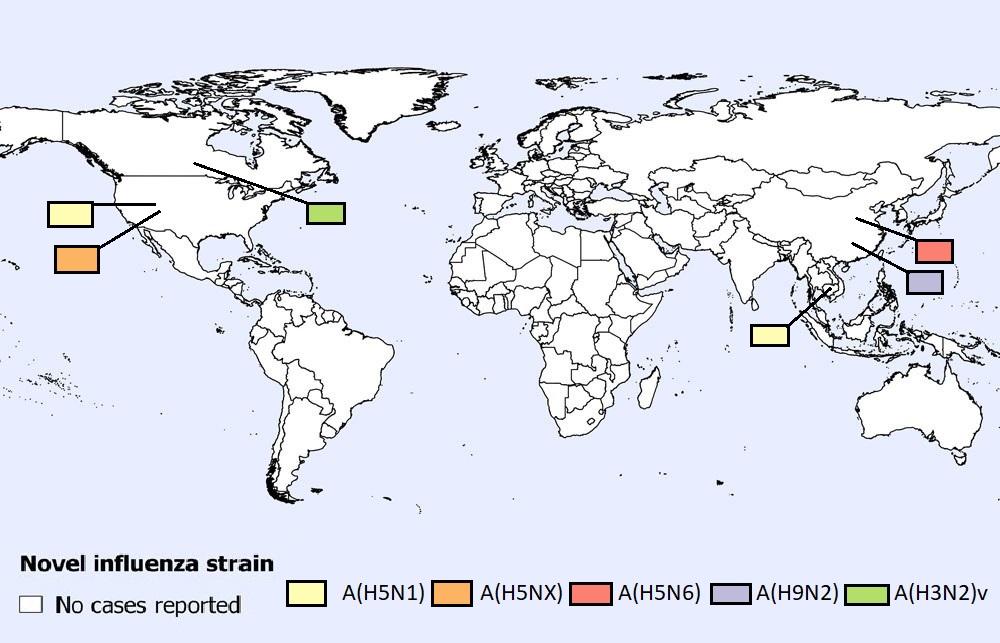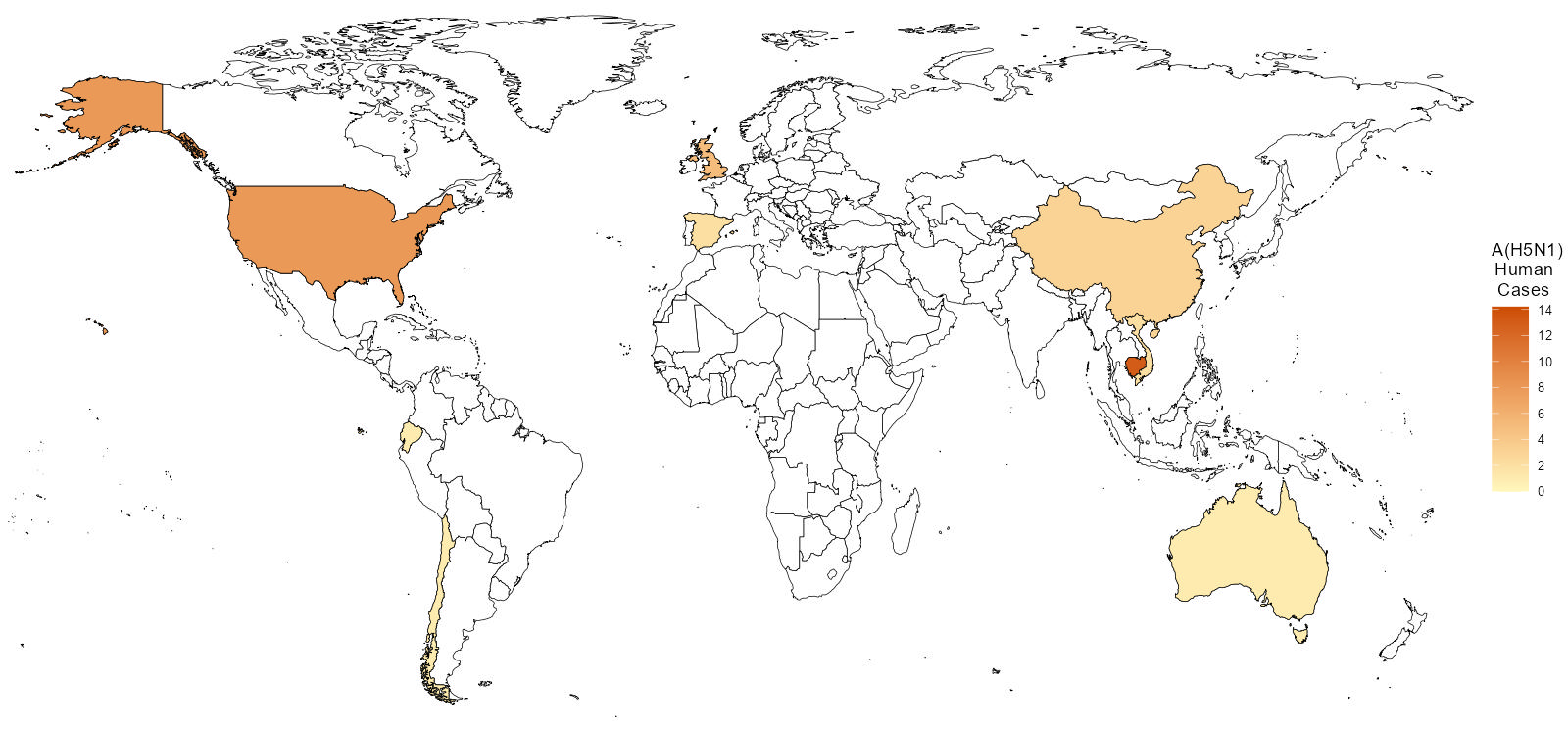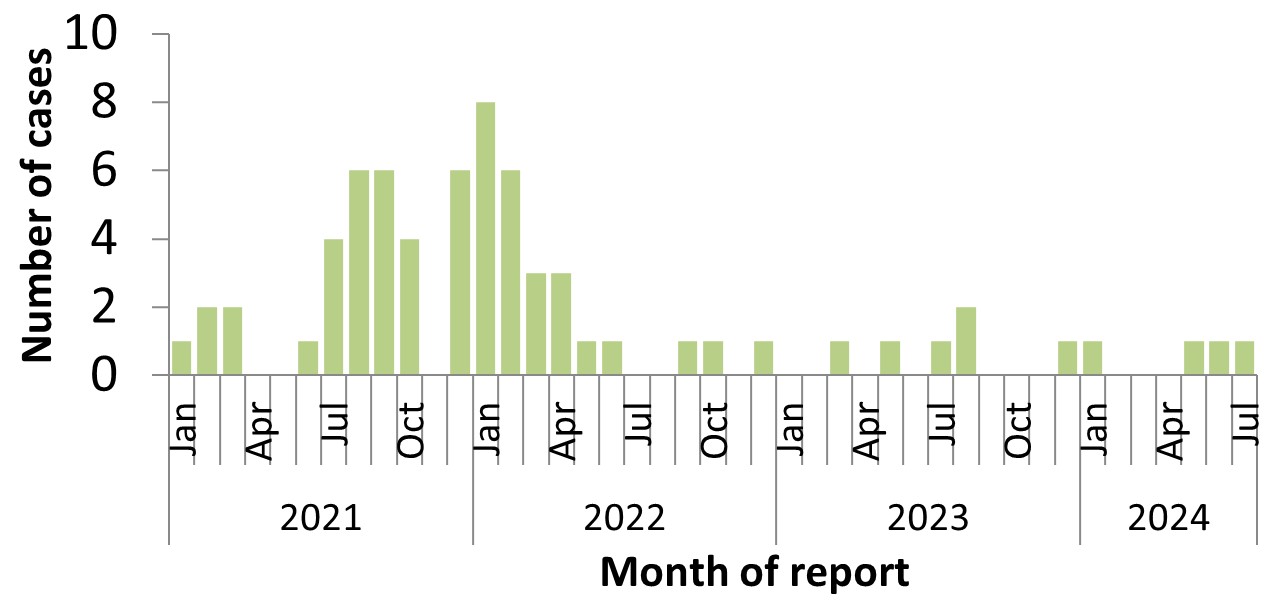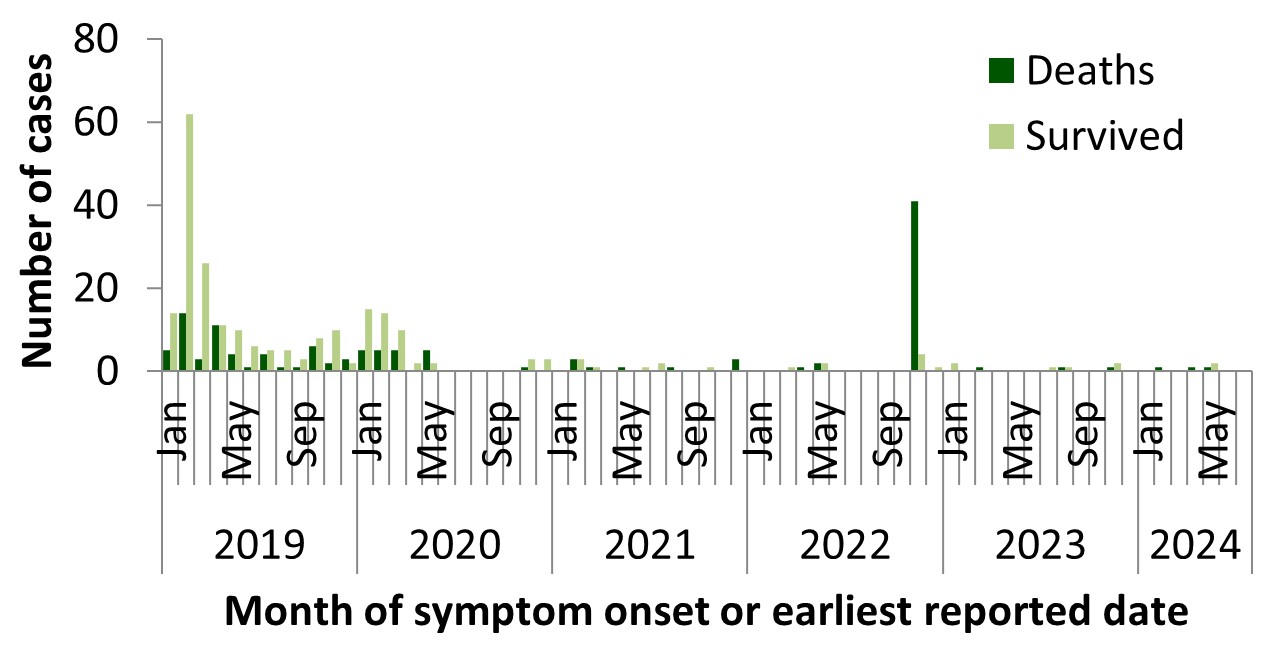Human emerging respiratory pathogens bulletin: Issue 91, July 2024

Download in PDF format
(601 KB, 5 pages)
Organization: Public Health Agency of Canada
Published: 2024-08-13
Cat.: HP38-6E-PDF
ISBN: 2563-9420
Pub.: 230012
Monthly situational analysis of emerging respiratory diseases affecting humans (data to July 31, 2024).
In this bulletin
- Avian influenza updates
- Swine influenza updates
- Middle East respiratory syndrome coronavirus (MERS-CoV) update
| Novel influenzaFootnote 1 | Cumulative Case CountFootnote 2 | Deaths | Case Fatality Rate %Footnote 3 | Date of Last ReportFootnote 4 |
|---|---|---|---|---|
| Avian Influenza | ||||
| A(H1N2)Footnote 5 | 2 | 0 | 0% | January 2019 |
| A(H3N8) | 3 | 1 | 33% | March 2023 |
| A(H5NX) Footnote 6 | 4 | 0 | 0% | July 2024 |
| A(H5N1) | 919 | 469 | 51% | July 2024 |
| A(H5N2) | 1 | 1 | 100% | May 2024 |
| A(H5N6) | 93 | 38 | 41% | July 2024 |
| A(H5N8) | 7 | 0 | 0% | February 2021 |
| A(H7N4) | 1 | 0 | 0% | February 2018 |
| A(H7N9) | 1,568 | 615 | 39% | April 2019 |
| A(H9N2) | 131 | 2 | 2% | July 2024 |
| A(H10N3) | 3 | 0 | 0% | April 2024 |
| A(H10N5) | 1 | 1 | 100% | January 2024 |
| Swine Influenza | ||||
| A(H1N1)v | 48 | 1 | 2% | February 2024 |
| A(H1N2)v | 54 | 0 | 0% | June 2024 |
| A(H3NX)vFootnote 7 | 1 | 0 | 0% | August 2023 |
| A(H3N2)v | 447 | 1 | <1% | July 2024 |
| A(H1NX)vFootnote 8 | 1 | 1 | 100% | November 2021 |
| Eurasian avian-like A(H1N1)v | 11 | 0 | 0% | September 2023 |
| MERS-CoVFootnote 1 | ||||
| Global Case CountFootnote 9 | 2,613 | 941 | 36% | May 2024 |
| - Within Saudi ArabiaFootnote 10 | 2,204 | 860 | 39% | May 2024 |
|
||||
The Human Emerging Respiratory Pathogens (HERP) Bulletin is a monthly publication developed by the Public Health Agency of Canada (PHAC)'s Centre for Emerging and Respiratory Infections and Pandemic Preparedness (CERIPP). The HERP Bulletin serves as a mechanism for information sharing on summary surveillance indicators of global, including domestic, public health events affecting humans in the field of emerging respiratory pathogens. This includes pathogens such as novel influenzas (both avian and swine-origin), Middle East Respiratory Syndrome Coronavirus (MERS-CoV), and other ad-hoc emerging respiratory pathogens.
Monthly Highlights
Events in Canada
During the month of July 2024, the following human case was reported in Canada:
- One new human case of swine-origin influenza A(H3N2)v
International Events
During the month of July 2024, the following human cases have been reported (Figure 1):
- Eight new human cases of avian influenza A(H5N1)
- Four new human cases of avian influenza A(H5NX)
- One new human case of avian influenza A(H5N6)
- One new human case of avian influenza A(H9N2)

Figure 1 - Text description
Six (6) A(H5N1) cases were reported in the Unites States.
Two (2) A(H5N1) cases were reported in Cambodia.
Four (4) A(H5NX) cases were reported in the Unites States.
One (1) A(H5N6) case was reported in China.
One (1) A(H9N2) case was reported in China.
One (1) A(H3N2)v case was reported in Canada.
Note: Map was prepared by CERIPP using data from the latest WHO Event Information Site (EIS) postings. This map reflects data available through these publications as of July 31, 2024.
Avian influenza updates
Avian influenza A(H5N1/H5NX)
Eight new human cases of avian influenza A(H5N1) and four new human cases of avian influenza A(H5NX) were reported in July 2024 from the US (10) and Cambodia (2).
In July 2024, six confirmed human cases of avian influenza A(H5N1) from a first farm and three confirmed human cases of avian influenza A(H5NX) from a second farm associated with poultry exposure were reported in Colorado. All cases had mild illness, and all have been offered the antiviral drug oseltamivir. Colorado state epidemiologists currently suspect the poultry worker cases are a result of working directly with infected poultry.
The status of additional close contacts and whether the workers were wearing proper personal protective equipment is unknown. US CDC confirmed the virus from the first farm in Colorado is A(H5N1) from clade 2.3.4.4b. The sequences are closely related to the viruses detected in recent poultry outbreaks and infected dairy cattle herds in the US. The virus remains primarily avian and lacks changes that would make it better able to infect or spread among humans. No additional genetic information about the most recent human cases (n=3) from the second farm in Colorado has been published at the time of this report.
In July 2024, the US CDC reported one new human case of A(H5NX) in Colorado that was associated with exposure to dairy cattle. Like two of the previous cases associated with dairy cattle from Michigan, he presented with only eye-related symptoms. Like the three previous cases with exposure to dairy cattle from Michigan, he was not hospitalized and has recovered. Investigation is underway. It is currently unknown if there are symptomatic individuals among contacts, or other farm workers exposed at the same farm. The number of contacts and exposed individuals under follow-up, as well as timeline of follow-up is unknown. The US CDC was not able to conclusively determine the neuraminidase (NA) subtype of the virus from this A(H5NX) human case.
The Cambodia Ministry of Health reported two new human cases of A(H5N1) in Takeo province. The first case was a 3-year-old male living in Po village. The case developed symptoms of fever, cough, tiredness, and difficulty breathing. Dead chicken were reported in the village roughly 10 days previously. The case had also brought food to eat and touched and held dead chicken at home. At the time of report, the case's condition had improved but he was still receiving intensive care. The second case was a 5-year-old female cousin of first case living in Po village. The second case lived in the same house as the first case. She developed fever but was not hospitalized. According to public health investigations, she touched the same dead chicken that was brought to the house to eat. Public health investigations are underway to find the source of transmission and to continue searching for other potential cases.
In 2024, 19 human cases of avian influenza A(H5N1) have been detected worldwide, from Australia (1), Cambodia (7), China (1), the United States (9), and Vietnam (1). This case count does not include the three most recent confirmed human cases of avian influenza A(H5NX) associated with poultry exposure and one (H5NX) human case in the US (1) that the US CDC was not able to conclusively determine the neuraminidase (NA) subtype of the virus. Since the start of the ongoing A(H5N1) worldwide outbreak in poultry and other animals in December 2021, 38 human cases of A(H5N1) have been reported worldwide (2022: n=6, 2023: n=13, 2024: n=19) in Australia (1), Cambodia (13), Chile (1), China (3), Ecuador (1), Spain (2), United Kingdom (5), United States (10), and Vietnam (2) (Figure 2). Of these cases, 17 of the viruses belong to the same strain of A(H5N1) that is associated with the current global outbreak in animals (clade 2.3.4.4b), 1 is tentatively from this same strain, 12 cases were infected with viruses that belonged to a different strain of A(H5N1) (clade 2.3.2.1c), and 1 is from clade 2.3.2.1a. The clade details of two cases from Cambodia, the travel-related case from China, and four cases from the US are unknown.
Since the emergence of A(H5N1) in humans in 1997, 919 human cases of A(H5N1) have been reported globally, with a CFR of 51% (Figure 3). In Canada, A(H5N1) detections associated with the current 2021-2024 A(H5N1) clade 2.3.4.4b epizootic have been reported in domestic, backyard, and wild bird populations, as well as other animal species. HPAI A(H5N1) has not been detected in dairy cattle, other livestock in Canada, or in raw milk. No domestically acquired human A(H5N1) infections have ever been reported in Canada; however, in 2014, Canada (Alberta) reported a single fatal case of A(H5N1) in a resident returning from travel in China.

Figure 2 - Text description
Thirteen (13) cases were reported out of Cambodia.
Five (5) cases were reported out of the United Kingdom.
Three (3) cases were reported out of China.
Two (2) cases were reported out of Spain.
One (1) case was reported out of Chile.
One (1) case was reported out of Ecuador.
Ten (10) cases were reported out of the United States of America.
Two (2) cases were reported out of Vietnam.
One (1) case was reported out of Australia.
Note: Map was prepared by CERIPP using data from the WHO EIS postings, the US CDC's Health Alert Network (HAN), and WHO cumulative case counts. This map reflects data available as of July 31, 2024.

Figure 3 - Text description
| Number of Cases | Deaths | Survived | |
|---|---|---|---|
| 1997 | 18 | 6 | 12 |
| 1998 | 0 | 0 | 0 |
| 1999 | 0 | 0 | 0 |
| 2000 | 0 | 0 | 0 |
| 2001 | 0 | 0 | 0 |
| 2002 | 0 | 0 | 0 |
| 2003 | 4 | 4 | 0 |
| 2004 | 46 | 32 | 14 |
| 2005 | 98 | 43 | 55 |
| 2006 | 115 | 79 | 36 |
| 2007 | 88 | 59 | 29 |
| 2008 | 44 | 33 | 11 |
| 2009 | 73 | 32 | 41 |
| 2010 | 48 | 24 | 24 |
| 2011 | 62 | 34 | 28 |
| 2012 | 32 | 20 | 12 |
| 2013 | 39 | 25 | 14 |
| 2014 | 52 | 22 | 30 |
| 2015 | 145 | 42 | 103 |
| 2016 | 10 | 3 | 7 |
| 2017 | 4 | 2 | 2 |
| 2018 | 0 | 0 | 0 |
| 2019 | 1 | 1 | 0 |
| 2020 | 1 | 0 | 1 |
| 2021 | 2 | 1 | 1 |
| 2022 | 5 | 1 | 4 |
| 2023 | 13 | 4 | 9 |
| 2024 | 19 | 2 | 17 |
Note: Graph was prepared by CERIPP using data from the WHO EIS postings, the US CDC's Health Alert Network (HAN), and WHO cumulative case counts. This graph reflects data available as of July 31, 2024.
Avian influenza A(H5N2)
The most recent human case of avian influenza A(H5N2) was reported in May 2024 from Mexico.
This was the first ever human case of avian influenza A(H5N2). The full spectrum of disease is unknown.
Avian influenza A(H5N6)
One new human case of avian influenza A(H5N6) was reported in July 2024 from China.
The case was a 70-year-old female from Anhui province, who had an illness onset date of June 17, 2024. On June 19, 2024, she was hospitalized with severe pneumonia and passed away on July 8, 2024. Prior to illness onset, the case had exposure to live poultry or to a live poultry market/wet market. Samples from close contacts and the environment tested negative. No secondary cases were detected.
In 2024, four human cases of avian influenza A(H5N6) were detected globally, all in China. In 2023, six human cases of avian influenza A(H5N6) were detected globally, all in China. Since January 2021, 67 cases of avian influenza A(H5N6) have been reported globally (2021: n=32, 2022: n=25, 2023: n=5, 2024: n=4) (Figure 4); the majority of cases (66) were reported from China and one case was reported from Lao PDR (Figure 4). Since the emergence of this virus in 2014, a total of 93 laboratory-confirmed human cases of avian influenza A(H5N6), including at least 38 deaths, have been reported globally (CFR: 41%). No cases have been reported in Canada.

Figure 4 - Text description
| Month | Cases | |
|---|---|---|
| 2021 | Jan | 1 |
| Feb | 2 | |
| Mar | 2 | |
| Apr | 0 | |
| May | 0 | |
| June | 1 | |
| July | 4 | |
| Aug | 6 | |
| Sep | 6 | |
| Oct | 4 | |
| Nov | 0 | |
| Dec | 6 | |
| 2022 | Jan | 8 |
| Feb | 6 | |
| Mar | 3 | |
| Apr | 3 | |
| May | 1 | |
| June | 1 | |
| July | 0 | |
| August | 0 | |
| Sep | 1 | |
| Oct | 1 | |
| Nov | 0 | |
| Dec | 1 | |
| 2023 | Jan | 0 |
| Feb | 0 | |
| Mar | 1 | |
| Apr | 0 | |
| May | 1 | |
| June | 0 | |
| July | 1 | |
| August | 2 | |
| Sep | 0 | |
| Oct | 0 | |
| Nov | 0 | |
| Dec | 1 | |
| 2024 | Jan | 1 |
| Feb | 0 | |
| Mar | 0 | |
| Apr | 0 | |
| May | 1 | |
| June | 1 | |
| July | 1 |
Note: Graph was prepared by CERIPP using data from the WHO EIS postings and the Hong Kong Centre for Health Protection (CHP) press releases. This graph reflects data available as of July 31, 2024.
Avian influenza A(H9N2)
One new human case of avian influenza A(H9N2) was reported in July 2024 from China.
The case was a 31-year-old female from Guizhou province, China, who had an illness onset and hospitalization date of June 15, 2024. The case experienced bronchitis, fever and cough, which were assumed to be symptoms of asthma. The case was discharged shortly after being examined. Due to persistent cough, the case sought care at another hospital on June 20, 2024, where she was diagnosed with influenza-like illness (ILI). Samples were collected on June 20 and tested positive for A(H9N2) on June 25, 2024. The case has since recovered. Prior to illness onset, the case had exposure to a live poultry market. Nine environmental samples from the wet market that the case was exposed to tested positive for H9. Samples from close contacts tested negative. No additional human cases of A(H9N2) associated with this case have been identified.
In 2024, nine human cases of avian influenza A(H9N2) have been reported worldwide, from China (7), India (1), and Vietnam (1). In 2023, a total of 15 human cases of avian influenza A(H9N2) were reported globally, all in China. Since the emergence of avian influenza A(H9N2) in the human population in 1998, 131 cases have been reported worldwide, with a CFR of 2%. No cases have been reported in Canada.
Avian influenza A(H10N3)
The most recent human case of avian influenza A(H10N3) was reported in April 2024 from China.
In 2024, one human case of avian influenza A(H10N3) has been reported worldwide. Since the emergence of avian influenza A(H10N3) in humans in 2021, three human cases have been reported, all from China, with a CFR of 0%. However, with only three human cases reported to date, the full spectrum of disease is highly uncertain. No cases have been reported in Canada.
Swine influenza updates
Swine origin influenza A(H1N1)v
The most recent human cases of swine origin influenza A(H1N1)v were reported in February 2024 from Brazil (1) and Spain (1).
In 2024, two human cases of swine origin influenza A(H1N1)v have been detected worldwide. There have been 5 human A(H1N1)v cases reported worldwide in 2023 in Brazil (1), China (2), Spain (1) and Switzerland (1). A total of 48 human cases of A(H1N1)v have been reported globally since 2005, with a 2% CFR. Two A(H1N1)v detections have been reported in Canadian residents since reporting began in 2005, with the first case reported in Ontario in September 2012 and the second case reported in Manitoba in April 2021 (see HERP Bulletin no 52).
Swine origin influenza A(H1N2)v
The most recent human cases of swine origin influenza A(H1N2)v were reported in June 2024 from the United States.
In 2024, three human cases of swine origin influenza A(H1N2)v were detected worldwide, all in the United States. In 2023, four human swine origin influenza A(H1N2)v cases were reported worldwide in Taiwan (1), the UK (1), and the United States (2). A total of 54 human cases of swine origin influenza A(H1N2)v have been reported globally since 2005, with a 0% CFR. Three swine origin influenza A(H1N2)v detections have been reported in Canadian residents since reporting began in 2005. The first case was reported in Alberta in October 2020 (see HERP Bulletin no 46), the second case was reported in Manitoba in April 2021 (see HERP Bulletin no 52) and the latest case in Canada was reported in November 2021 in Manitoba (see HERP Bulletin no 59).
Swine origin influenza A(H3N2/H3NX)v
One new human case of swine origin influenza A(H3N2)v was reported in July 2024 from Canada.
The case was a child (< 18 years old) from Saskatchewan, Canada. On June 10, 2024, the case developed symptoms including decreased appetite, arthralgia, dizziness, fatigue, otitis, rhinorrhea, nasal congestion, sore throat, and sputum production. On June 16, 2024, the case sought emergency medical care. The case was not hospitalized and has since recovered. Public health officials found no known exposure to symptomatic persons or animals prior to symptom onset. The case lives on a farm with cattle and swine but reported no direct contact with the livestock. There are no reports of symptomatic cattle or swine on the farm, nor symptomatic contacts of the case.
To date, one human case of swine origin influenza A(H3N2)v has been reported worldwide in 2024. Excluding the reported case of A(H3NX)v in the United States (1), no cases of swine origin influenza A(H3N2)v were detected in 2023. Globally, 447 swine origin influenza A(H3N2)v cases have been reported since 2005, with <1% CFR. This is the fourth human case of swine origin influenza A(H3N2)v reported in Canada since 2005. The first case of A(H3N2)v in Canada was reported in Ontario in 2005. This was followed by a second case in Ontario in 2016 and a third case in Manitoba in June 2021 (see HERP Bulletin no 54).
Middle East respiratory syndrome coronavirus (MERS-CoV) update
The most recent human cases of MERS-CoV were reported in May 2024 from Saudi Arabia.
To date, five new human cases of MERS-CoV have been reported in 2024, all from Saudi Arabia. In 2023, ten cases of MERS-CoV were reported in Oman (1), Saudi Arabia (8), and the United Arab Emirates (1). According to the WHO, 2,613 laboratory-confirmed cases of MERS-CoV, including 941 deaths, have been reported globally since reporting began in 2012 (CFR: 36%) (Figure 5). No cases have ever been reported in Canada.

Figure 5 - Text description
| Deaths | Survived | ||
|---|---|---|---|
| 2019 | Jan | 5 | 14 |
| Feb | 14 | 62 | |
| Mar | 3 | 26 | |
| Apr | 11 | 11 | |
| May | 4 | 10 | |
| June | 1 | 6 | |
| July | 4 | 5 | |
| Aug | 1 | 5 | |
| Sep | 1 | 3 | |
| Oct | 6 | 8 | |
| Nov | 2 | 10 | |
| Dec | 3 | 2 | |
| 2020 | Jan | 5 | 15 |
| Feb | 5 | 14 | |
| Mar | 5 | 10 | |
| Apr | 0 | 2 | |
| May | 5 | 2 | |
| June | 0 | 0 | |
| July | 0 | 0 | |
| Aug | 0 | 0 | |
| Sep | 0 | 0 | |
| Oct | 0 | 0 | |
| Nov | 1 | 3 | |
| Dec | 0 | 3 | |
| 2021 | Jan | 0 | 0 |
| Feb | 3 | 3 | |
| Mar | 1 | 1 | |
| Apr | 0 | 0 | |
| May | 1 | 0 | |
| June | 0 | 1 | |
| July | 0 | 2 | |
| Aug | 1 | 0 | |
| Sep | 0 | 0 | |
| Oct | 0 | 1 | |
| Nov | 0 | 0 | |
| Dec | 3 | 0 | |
| 2022 | Jan | 0 | 0 |
| Feb | 0 | 0 | |
| Mar | 0 | 1 | |
| Apr | 1 | 0 | |
| May | 2 | 2 | |
| June | 0 | 0 | |
| July | 0 | 0 | |
| August | 0 | 0 | |
| Sep | 0 | 0 | |
| Oct | 0 | 0 | |
| Nov | 41 | 4 | |
| Dec | 0 | 1 | |
| 2023 | Jan | 0 | 2 |
| Feb | 0 | 0 | |
| Mar | 1 | 1 | |
| Apr | 0 | 0 | |
| May | 0 | 0 | |
| June | 0 | 0 | |
| July | 0 | 1 | |
| August | 2 | 1 | |
| Sep | 0 | 0 | |
| Oct | 0 | 0 | |
| Nov | 1 | 2 | |
| Dec | 0 | 0 | |
| 2024 | Jan | 0 | 0 |
| Feb | 1 | 0 | |
| Mar | 0 | 0 | |
| Apr | 1 | 0 | |
| May | 1 | 2 | |
| June | 0 | 0 | |
| July | 0 | 0 |
Note: Graph was prepared by CERIPP using data from the WHO Disease Outbreak News (DON) and Saudi Arabia's Ministry of Health. This graph reflects data available as of July 31, 2024. The data integrates CERIPP real-time reporting with WHO DON retrospective reporting of MERS-CoV cases and deaths. In November 2022, the WHO published a DON article that updated their counts with retrospective cases and deaths, which resulted in an increase of an additional 5 cases and 41 deaths compared to their previous MERS-CoV-related DON. In August 2023, the WHO published a DON article with case information for three retrospective MERS-CoV cases and two deaths. These three cases and one death were already reflected in the cumulative case count of the DON article published in July 2023, as well as the case totals published in HERP Bulletin no 79. In May 2024, the WHO published a DON article with case information for one single, fatal case of MERS-CoV. This fatal case was already reflected in the case totals published in HERP Bulletin no 88.